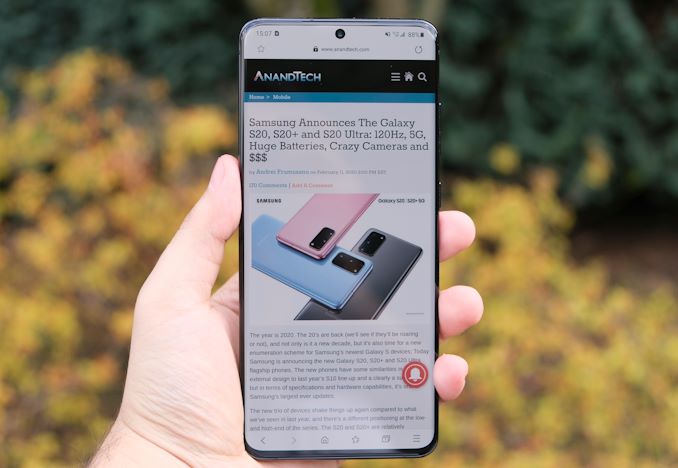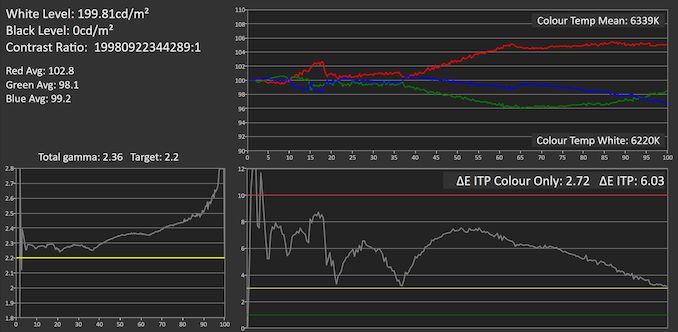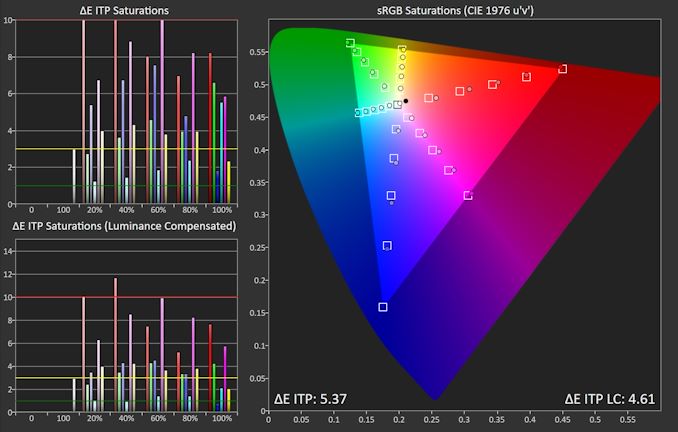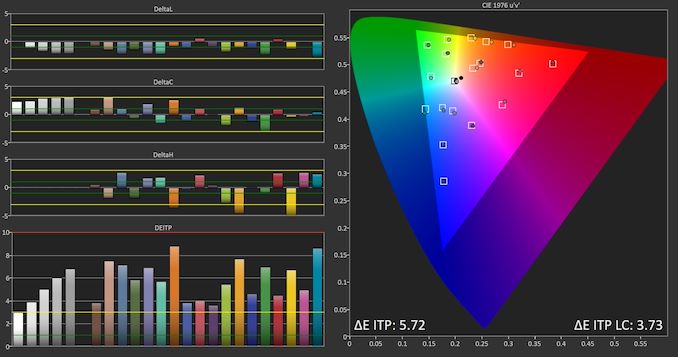The Samsung Galaxy S20+, S20 Ultra Exynos & Snapdragon Review: Megalomania Devices
by Andrei Frumusanu on April 3, 2020 9:30 AM ESTDisplay Measurement
The Galaxy S20’s screens follow the same recipe that we found on the S10 and Note10 series, and other than the 120Hz display modes, the new panels don’t have any major new changes to them when it comes to features or display quality changes.
We move on to the display calibration and fundamental display measurements of the Galaxy S20 screen. As always, we thank X-Rite and SpecraCal, as our measurements are performed with an X-Rite i1Pro 2 spectrophotometer, with the exception of black levels which are measured with an i1Display Pro colorimeter. Data is collected and examined using Portrait Display's CalMAN software.

In terms of brightness, the S20 Ultra and S20+ fall in line with what we’ve seen from Samsung phones over the past few generations. The panel goes up to 325 nits in maximum manual brightness mode, and boosts up to 731 nits at full screen white when under auto brightness and high ambient light. The lower the APL of your content, the brighter the screen will become.
The S20 series is identical to the S10 series when it comes to the display settings; we find the phone comes by default in a “Vivid” mode with a larger color gamut target for all content. But what’s new here is that this generation Samsung has included a color temperature slider offering not only a few discrete choices between cool and warm, but it also gives the option for fine-tuning the RGB balance as well. Nevertheless, the accurate color profile for the phone is the “Natural” one which aims for sRGB colors for default contents and is able to support wider color targets for color managed applications.
Unfortunately, the S20 doesn’t really behave any different to the S10 series, and we find the same characteristics in the calibration between the phones. The worst offender here is the color temperature which is far too warm at an average of 6330K across all grey levels, and a white falling in at 6220K. Samsung keeps doing this year after year and at this point I just don’t know what the point is anymore in hoping that they would finally get it right.
The resulting gamma is also quite off and will wildly vary in the measurement depending on your pattern’s APL. We’ve had tons of phones fail at this aspect as the panels are calibrated without consideration of the CABC mechanisms of the display – for some vendors it’s even possible to retrace the methodologies and showcase where they went wrong in the calibration.
At this point I should note that we’ve slightly revamped our display reporting methodology, and have now moved from showcasing dE2000 error values to the newer dEITP standard, which is more strict in its error figure handling.
The S20 Ultra here ends up with a dEITP of 6.03 because of the color and luminosity errors, and just the color error would lend it a dEITP of 2.72. I’ll be remeasuring more devices and bring back comparison charts on other devices with the new dE standard in upcoming reviews.
Saturation targets for the S20 are also in line with what we’re used to from Galaxy phones – not great, but not totally bad either. The major issue again is the shift of the spectrum towards reds.
The Gretag MacBeth chart with common human color tones is also just somewhat acceptable, with the commonality of gamma errors, but also some larger hue errors due to the shift towards reds.
A Typical Galaxy Display
Overall, the S20 series come with what I’d call typical Galaxy displays. The panel is fantastic quality, and there’s nothing to criticize it in terms of its intrinsic qualities. The calibration is a bit more lackluster and in-line with what we’ve become accustomed from Samsung, key points being that the gamma is off yet again, and the Natural display mode is also too warm, yet again. It’s not a deal breaker, but Samsung has done better in the past. In any case, they remain high quality displays which are just short of being outstanding.
















137 Comments
View All Comments
iSeptimus - Sunday, April 12, 2020 - link
They really don't. 2 years max on updates and the security patches only come out when it is critical after that.My Galaxy Fold only just got One UI 2.1 and Android 10. The most expensive phone they do and they are already slowing down updates for it. Samsung suck at software.
MAGAover9000 - Tuesday, April 7, 2020 - link
Sounds like a positive TBH. I hate some of the updates.Omega215D - Friday, April 3, 2020 - link
That's for the maxed out S20 Ultra, what S10 are you comparing it to? There are the following additions to the S20 lineup: camera tech, 5G, battery capacities, mobile chipsets, display tech, etc. Now not everyone may find those attractive enough to jump on board that doesn't mean they have to buy the damn thing.Threska - Friday, April 3, 2020 - link
5G is probably the biggest push for cost, since 5G phones usually run in the $1,000 range.Andrei Frumusanu - Friday, April 3, 2020 - link
The Galaxy S20 and S20+ 4G variants have the same launch prices as S10 and S10+ - with the only caveat being that they're only available in certain markets, with the US missing from that list.So in that sense, the only thing you're paying extra for is the 5G.
FunBunny2 - Friday, April 3, 2020 - link
"5G phones usually run in the $1,000 range"I still don't get why anyone would pay for "5G". mmWave is barely extant. Verizon, for one, adverts pump up use in football stadiums (if we ever have such), 'so it must be great for you' kind of thing. while sub6 is barely perceptibly different LTE. Why? If there's ever a true build out of mmWave, it'll be in suburban subdivisions with plenty of street lights, no longer the norm. In cities, you'll need some sort of '5G' wifi inside any kind of building with a (massive?) dish on the roof. Ah cannaw change da laws of physic, capn.
shabby - Friday, April 3, 2020 - link
We don't have a choice, Qualcomm is forcing it onto us.s.yu - Friday, April 3, 2020 - link
Qualcomm's going with the flow of the industry, there's no way but forward ;)But anyway, the Luneburg lenses China Mobile showcased, if they're compatible with mmWave, and if they're even willing to sell them(the issue is cost and somehow they're able to make them much cheaper, cheap enough for civilian use), then they could drastically increase coverage at essentially the same power levels.
PeachNCream - Friday, April 3, 2020 - link
Yup, that's a lot to pay for something that you carry around on a daily basis and expose to the outdoor world including weather, impact, and theft. I know the TELCOs are hiding the cost inside monthly payments over the life of a contract so most buyers will not take note of the price over say an $800 dollar handset, but wow people are forking over a lot of their earnings just to carry around a status symbol that other people will stop caring about after a couple of months.FunBunny2 - Friday, April 3, 2020 - link
"wow people are forking over a lot of their earnings just to carry around a status symbol"why does a Ferrari cost 3 times a Ford (not the GT, of course)? because the capital investment to make either is nearly the same, but spread out over a fraction of units. same with "5G" phones. the capital to make all those specialized bits and pieces, whether Samsung made or bought it, is about the same, but separate, from the capital to make a moto G6, etc. but far fewer units. unlike the march to LTE, "5G" is more likely to be a toddler's waddle. with sky high prices as an added benefit.
there was a headline recently that the Swiss watch industry is on a ventilator, few have any need for such bling. can the bling smartphone be far behind? at least your scion can use that Patek Philippe in 50 years.